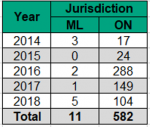Rabies
Rabies
The last human rabies case due to animal exposures in Ontario was reported in 1967.1 Although extremely rare in Canada, human rabies infections are almost always fatal. It is important for public health to remain vigilant about investigating possible rabies exposures and recommending post-exposure prophylaxis (PEP) when required.
Between 2014 and 2018 the occurrence of rabies being confirmed in animals in Middlesex-London was low, despite a general increase across Ontario in 2016. The number of Middlesex-London residents assessed for possible rabies exposure steadily increased between 2010 and 2018. During that time period, 11.8% of exposures were deemed higher risk and resulted in public health recommending PEP.
Rabies exposure investigations and post-exposure prophylaxis (PEP)
View more information about rabies in Ontario wildlife and rabies exposure investigations.
In the five years between 2014 and 2018, 11 animals in the Middlesex-London region were confirmed with rabies. Across Ontario, the number of rabid animals identified increased dramatically in 2016 (n=288). Although the number of confirmed rabid animals steadily declined after that, the provincial count has not returned to pre-2016 levels (Figure 14.5.1).
Across Ontario, several different animal species were confirmed to have rabies between 2014 and 2018, including bats, foxes, raccoons, and skunks, as well as a small number of domesticated animals such as cats, cows, and llamas. In the Middlesex-London region, though, all animals reported positive for rabies across the four-year time period were bats (data not shown).
More than 9,000 individuals in Middlesex-London were assessed between 2008 and 2018 for possible rabies exposure after being bitten or scratched by an animal. Since 2010, the number of rabies exposure investigations consistently increased; the number more than doubled between 2010 (n=460) and 2018 (n=1,094) (Figure 14.5.2).
Between 2008 and 2018, the number of rabies exposure investigations where PEP was recommended varied, representing between 9.1% and 27.6% of all rabies exposure investigations depending on the year. However, since 2015 the number of PEP recommendations steadily increased. In 2018, PEP was recommended in 11.2% of all investigations (Figure 14.5.2).
Between 2014 and 2018 the number of animals confirmed to have rabies in Middlesex-London was low, suggesting that the risk to residents was similarly low. However, the count may under-represent the true occurrence of rabies in the region, since only animals that were captured and tested were included in these results.
The risk of rabies infection to the public was mitigated through rabies exposure investigations conducted by public health.2 The number of Middlesex-London residents assessed for possible rabies exposure steadily increased between 2010 and 2018. During that time period, 11.8% of exposures resulted in PEP being recommended for the individual.
In 2009, guidance regarding the management of potential rabies exposures and the associated criteria for recommending PEP were updated.3 Changes in risk assessment and management protocols may contribute to some of the variability in the number and proportion of rabies exposure investigations resulting in a PEP recommendation.
Ontario Public Health Standards: Requirements for Programs, Services, and Accountability – Infectious and Communicable Diseases Prevention and Control (pages 42-47)
Infectious Diseases Protocol, 2018
Population Health Assessment and Surveillance Protocol, 2018
References:
1. Ontario Agency for Health Protection and Promotion (Public Health Ontario). Rabies [Internet]. Toronto ON: Ontario Agency for Health Protection and Promotion’ [cited 2019 Nov 13]. [about 2 screens]. Available from: https://www.publichealthontario.ca/en/diseases-and-conditions/infectious...
2. Ontario Ministry of Health and Long-Term Care. Management of potential rabies exposure guideline, 2019 [Internet]. Toronto (ON): Queen’s Printer of Ontario; 2019 Feb [cited 2019 Nov 4]. 21 p. Available from: http://www.health.gov.on.ca/en/pro/programs/publichealth/oph_standards/d...
3. National Advisory Committee on Immunization (NACI). Recommendations regarding the management of bat exposures to prevent human rabies. Can Commun Dis Rep [Internet]. 2009 Nov [cited 2019 Nov 1];35(ACS-7):1-28. Available from: https://www.canada.ca/en/public-health/services/reports-publications/can...
Last modified on: November 19, 2019
Jargon Explained
Rabies post-exposure prophylaxis (PEP)
Treatments that aim to prevent the development of rabies in a person who has been bitten or scratched by a potentially rabid animal. This includes receiving rabies immunoglobulin (a blood product containing rabies antibodies) and/or a series of rabies vaccines, so that the person’s body mounts an immune response against the rabies virus that may be present.

